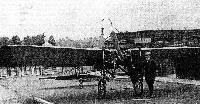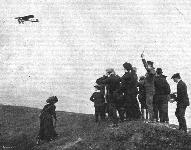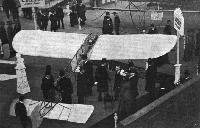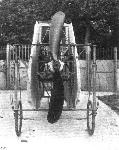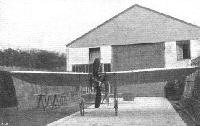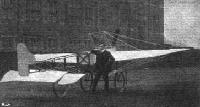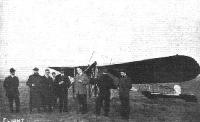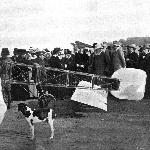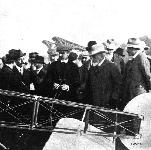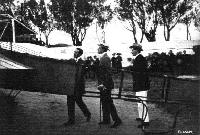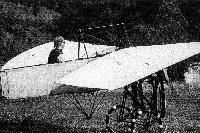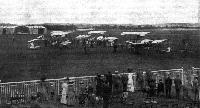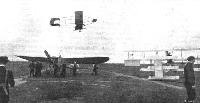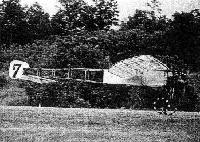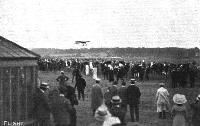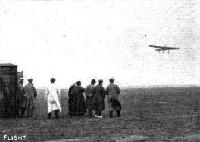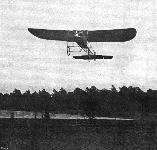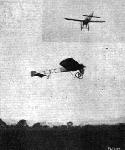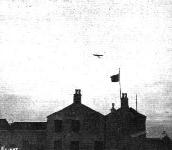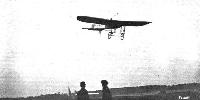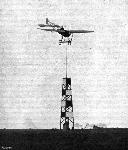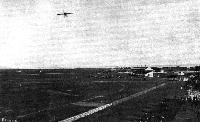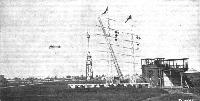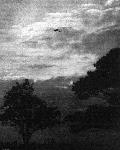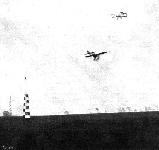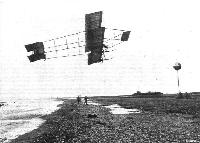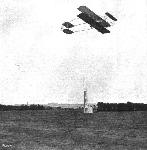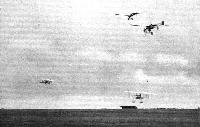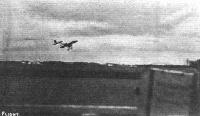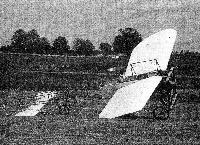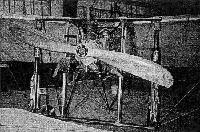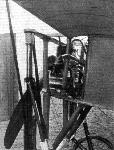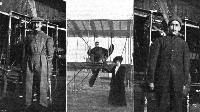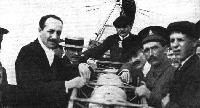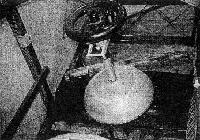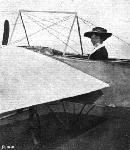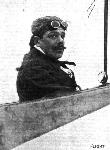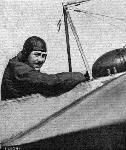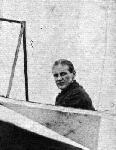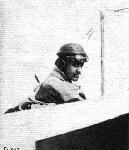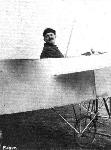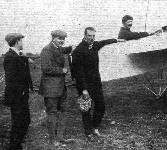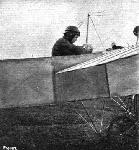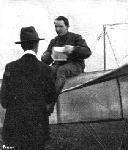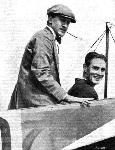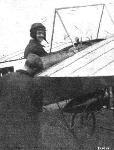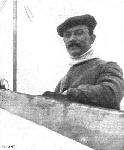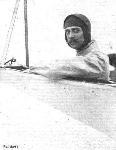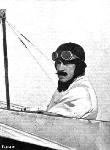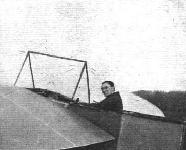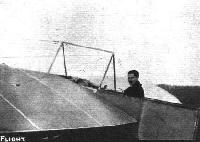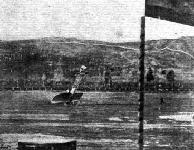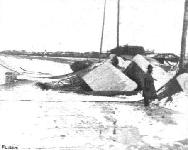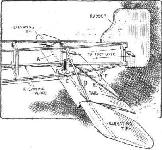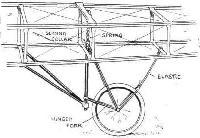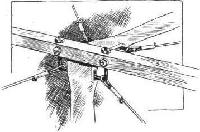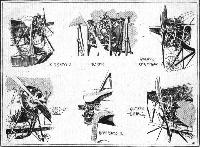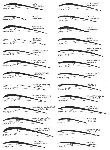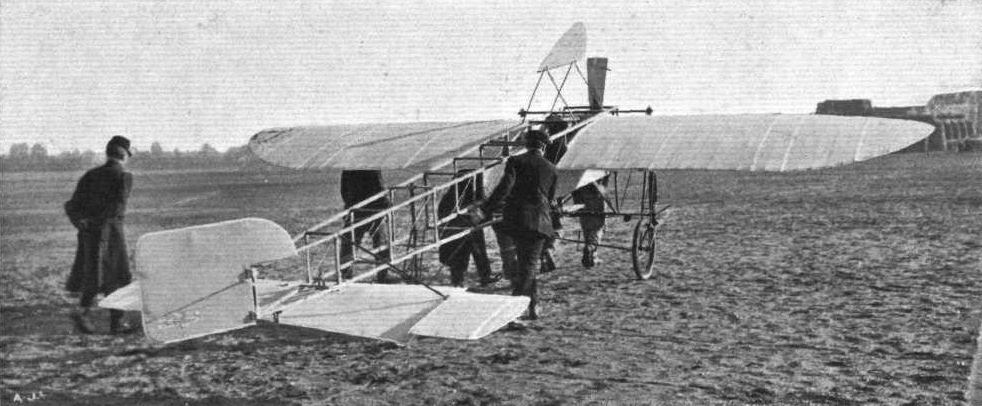
Описание
Страна: Франция
Год: 1909
.
Варианты
- Bleriot - Bleriot-XI - 1909 - Франция
- Bleriot - Bleriot-XIbis / Bleriot-XIV - 1910 - Франция
- Ребиков Н.В., Щетинин С.С. - Россия-Б - 1910 - Россия
- Стасенко Н.П. - Люсик - 1910 - Россия
- Bleriot - Bleriot-XI-2 - 1911 - Франция
- Bleriot - Bleriot-XI-3 - 1911 - Франция
- Гризодубов С.В. - Гризодубов-4 - 1912 - Россия
- Bleriot - Bleriot-XI Parasol - 1914 - Франция
- В.Кондратьев Самолеты первой мировой войны
- А.Шепс Самолеты Первой мировой войны. Страны Антанты
- В.Шавров История конструкций самолетов в СССР до 1938 г.
- J.Davilla, A.Soltan French Aircraft of the First World War (Flying Machines)
- A.Durkota, T.Darcey, V.Kulikov The Imperial Russian Air Service (Flying Machines)
- L.Opdyke French Aeroplanes Before the Great War (Schiffer)
- M.Goodall, A.Tagg British Aircraft before the Great War (Schiffer)
- Журнал Flight
-
А.Шепс - Самолеты Первой мировой войны. Страны Антанты
Спортивный самолет "Блерио-XI" (1909г.)
-
А.Шепс - Самолеты Первой мировой войны. Страны Антанты
Учебный/спортивный самолет "Блерио-XI-бис" (1910г.)
-
Журнал - Flight за 1909 г.
"BLERIOT No. 11." - Rear view of the short-span Bleriot, showing the steering tips on the tail. The span of the wings is 7 metres, the area 15 square metres, the weight 230 kilogs., and the engine a 7-cyl, 25-h,p. R.E.P.
-
Журнал - Flight за 1909 г.
"BLERIOT No. 11." - Side view of the short-span Bleriot taken on Issy Parade Ground during the experiments.
-
Журнал - Flight за 1909 г.
M. Bleriot during his 36m. 55s. flight at Issy last Saturday on his monoplane "No. XI."
-
Журнал - Flight за 1909 г.
M. BLERIOT'S GREAT CROSS-COUNTRY FLIGHT. - The start from Mondeslr, near Etampes. M. Bleriot is in the aviator's seat, and M. Anzani is just starting the motor of which he is the maker.
-
Журнал - Flight за 1909 г.
M. BLERIOT'S GREAT CROSS-COUNTRY FLIGHT. - During his great flight from Etampes to Orleans, M. Bleriot passed over the railway line just before reaching Artenay at the same time as the Bordeaux express was on its way. This unique incident is seen above.
-
Журнал - Flight за 1909 г.
M. BLERIOT'S GREAT CROSS-COUNTRY FLIGHT. - M. Bleriot In full flight on his long cross-country journey passing over the village of Monerville.
-
Журнал - Flight за 1909 г.
M. BLERIOT'S GREAT CROSS-COUNTRY FLIGHT. - After covering the 25 miles across country, M. Bleriot alighted at the pre-arranged spot - La Croix-Biquet - about 15 kiloms. from Orleans. Immediately after his descent the whole machine was dismantled ready for transport back to its shed. The process of dismantling is seen above.
-
M.Bowden - The Great War's Finest. Volume1: Western Front 1914 /Aeronaut/ (1)
Photographs from Louis Bleriot's famous Channel crossing flight. (Courtesy of the Library of Congress)
-
Журнал - Flight за 1909 г.
M. BLERIOT'S CHANNEL FLIGHT ON SUNDAY MORNING, JULY 25th, 1909. - The start for the crossing from Baraques.
-
Журнал - Flight за 1909 г.
M. Bleriot's sketch of his cross-Channel flight. - In the Daily Mail the above very interesting "chart" sketch by M. Bleriot on Sunday, was published on Monday. The explanation of the drawing is: - The lettering: "Louis Bleriot, arrived in England at 5.12, left France at 4.35." "Cal," in the bottom right-hand corner, means Calais. The black dot is the point of departure, and the line the line of flight. The significant "Rien" and the mark of interrogation indicate the point at which the aviator was for 10 mins. completely lost. " Vent " = wind, and "Fal." = falaise or cliff. "Dou." = Douvres, Dover - and the perpendicular line the lie of the coast. Note how the line of flight is well to the east of Dover and how M. Bleriot's chart illustrates the distance he had to beat westward against the wind before finding a place to land in the Northfall meadow.
-
Журнал - Flight за 1909 г.
AN HISTORICAL EVENT. - M. Bleriot and his monoplane flyer at the spot where he landed in the Northfall meadow, behind Dover Castle, on Sunday morning, 5.20 a.m. (English time 5.14 a.m.), July 25th, 1909, after flying the Channel, having left the French coast at Baraques at 4.40 a.m. (French time) the same morning. The constable on the right is P.C. Stanford, who is believed to be the only person who actually saw M. Bleriot alight on British soil. M. Bleriot himself is easily identified in front in his overalls and aviator's cap.
-
G.Loening - Takeoff into Greatness /Putnam/
Louis Bleriot lands on a hillside near Dover, England.
-
P.Jarrett - Pioneer Aircraft: Early Aviation Before 1914 /Putnam/
Louis Bleriot crossed the English Channel in his Anzani-powered No XI monoplane on 25 July 1909, thus securing undying fame and worldwide orders for his aeroplane. This picture of the cross-Channel aeroplane was taken after the event.
-
L.Opdyke - French Aeroplanes Before the Great War /Schiffer/
The cross-Channel Anzani Bleriot XI safely back in France. Note the bladder inside the fuselage, against sinking, and the tall rudder.
-
Журнал - Flight за 1910 г.
BLERIOT'S CROSS-CHANNEL FLYER. - As a souvenir of M. Bleriot's historic feat in flying across the Channel, Messrs. Bleriot, Ltd., the London manufacturers of the famous lamps designed by M. Bleriot, have issued postcards, reproduced above, showing the flyer as it appeared when on exhibition in London afterwards. These can be obtained at the Company's stand at Olympia during the present Show.
-
Журнал - Flight за 1910 г.
THE SECOND CROSS-CHANNEL FLIGHT. - M. Jacques de Lesseps, on his Bleriot, passing over the cliffs at Dover on Saturday last. A good specimen of a "composite" photograph.
-
Журнал - Flight за 1910 г.
M. JACQUES DE LESSEPS' CHANNEL FLIGHT. - His Bleriot machine immediately after landing near Dover.
-
Журнал - Flight за 1909 г.
PARIS FLIGHT SALON. - General view of the centre of the Grand Palais, showing the "Stands of Honour." In the middle, immediately under the spherical gas-bag, is the famous Bleriot cross-Channel machine. To its right is the "Rep" monoplane, in the extreme right foreground is the Farman biplane, to the left a French-made Wright flyer, and continuing round to the left the machines are respectively an Antoinette, a Voisin, and another Bleriot. The decorated spherical balloon in the distance is the Montgolfier.
Другие самолёты на фотографии: Antoinette Antoinette VII - Франция - 1909Farman Farman-III - Франция - 1909REP REP-1 / REP-2 - Франция - 1907Voisin Voisin-Delagrange / Voisin-Farman - Франция - 1907Wright Wright III / Wright A - США - 1905
-
Журнал - Flight за 1909 г.
PARIS FLIGHT SALON. - View looking down the Grand Palais. The machines seen prominently in the stands are - on the right a Chauviere (makers of the famous propellers), a Vintlon helicoptere, and then two Bleriots; on the left side are a Dutheil-Chalmers biplane, a "W.L.D." monoplane, the Henriot monoplane, and two Antoinettes. Hanging from the roof is the gas-bag of one of the Zodiac dirigibles, and in the far distance the great yellow spherical balloon of the Continental Co.
Другие самолёты на фотографии: Antoinette Antoinette VII - Франция - 1909Chauviere biplane - Франция - 1909Dutheil-Chalmers biplane - Франция - 1909Liore et Olivier monoplane - Франция - 1909
-
Журнал - Flight за 1910 г.
THE PRINCE AND PRINCESS OF WALES AT OLYMPIA. - Our photograph was secured during the inspection of the famous Louis Bleriot monoplane. On the stand are also Prince Francis of Teck, Mr. Roger W. Wallace, K.C., Chairman of the Royal Aero Club; the Hon. C. S. Rolls, who drove the Prince and Princess on his car from Marlborough House and back, and explained many points of interest in the exhibits during the Royal party's tour of Olympia; Mr. Edward Manville, President of the S.M.M.T.; and Mr. Norbet Chereau, manager for M. Bleriot.
-
Журнал - Flight за 1910 г.
The Bleriot monoplane, with its main planes folded up ready for housing or travelling.
-
Журнал - Flight за 1910 г.
Under the method of construction of his monoplanes M. Bleriot does away with the necessity of huge places for housing them. The main planes can be quite readily folded down to the sides, the whole being brought well within the compass of the main framework. In the above photograph a Bleriot is seen with its planes fully set after coming out of its dock, seen behind. In our other photo the same machine is seen folded up.
-
Журнал - Flight за 1910 г.
HOW AN AEROPLANE ARRIVES AT AN AERODROME. - Mr. Grahame-White superintending the unpacking of his monoplane; and, on the right, assisting in its erection.
-
Журнал - Flight за 1910 г.
GRAHAME-WHITE'S BLERIOT, SHOWING THE CENTRAL ARRANGEMENTS. - On the right, a view taken from the tail end shows the pilot's seat, control pillar and wheel warping arrangement and metal splash-board to protect the aviator from oil.
-
Журнал - Flight за 1910 г.
A Bleriot type machine just completed by Messrs. Hill and Co., of Bury, Lancashire.
-
Журнал - Flight за 1910 г.
Mr. Vivian V. D. Hewitt's Bleriot.
-
Журнал - Flight за 1913 г.
Mr. Vincent Fill and the Anzani-Bleriot built by himself.
-
Журнал - Flight за 1909 г.
Mr. G. W. Parkinson, of Gosforth, Northumberland, at the wheel of his Bleriot monoplane. Mr. Parkinson, as we recorded, made his initial flight at Newcastle three weeks ago.
-
Журнал - Flight за 1910 г.
Last week the Bleriot monoplane which is being exploited by Mr. Albert House, Managing Director of the Northern Aero Syndicate at Bradford, was out for practice at the Company's Apperley Bridge flying ground, and some interesting short flights were obtained. Unfortunately, at the finish, when taking a turn to avoid a wall, the machine came to grief. Our photographs above show the machine before and after the mishap. In the left-hand photo is Mr. J. W. House, at the wheel, and standing behind the figure 5 is Mr. Albert House, junr. In the right-hand photograph, from left to right, are Mr. J. W. House, Mr. Albert House, junr., and Mr. Albert House.
-
Журнал - Flight за 1910 г.
AT THE BLERIOT SCHOOL, HENDON (LONDON AERODROME). - From left to right: Mr. P. Prier (instructor), Mr. E. A. Paul, Capt. Board, Mr. Bouwens, Mr. Petitpierre, Mr. Grabette.
-
M.Goodall, A.Tagg - British Aircraft before the Great War /Schiffer/
Bleriot XI single-seater. The earlier version was the inspiration for many British constructors.
-
Журнал - Flight за 1910 г.
KING EDWARD AT BIARRITZ AVIATION MEETING. - His Majesty questioning M. Bleriot upon details of his monoplane.
-
Журнал - Flight за 1910 г.
A Typical Incident in the Career of the Monarch, Counsellor, Sage, and Sportsman, whose Death has cast a gloom over Five Continents.
-
Журнал - Flight за 1910 г.
King Alfonso of Spain (in centre) takes intense Interest in the Bleriot of M. Morane at San Sebastian.
-
Журнал - Flight за 1911 г.
Mrs. Asquith, Miss Asquith, and Master Asquith watching Mr. Gustav Hamel preparing his Bleriot monoplane on Saturday at Brooklands, in readiness for the flight to Brighton.
-
Журнал - Flight за 1912 г.
AVIATION IN SOUTH AFRICA. - On the left Mr. Compton-Paterson and Mr. Driver in the Good Hope Gardens with Captain Livingstone (in centre), who is associated with this aviation enterprise. On the right Mr. Driver ready for a start on his Bleriot.
-
Журнал - Flight за 1910 г.
Mr. Claude Grahame-White bringing back his Bleriot to its dock at Brooklands after some short flights last Saturday. Mr. Grahame-Whlte is seen in front helping to pull by the chassis.
-
P.Jarrett - Pioneer Aircraft: Early Aviation Before 1914 /Putnam/
A close-up showing the wing-warp control cables of the Bleriot XI. Wires from the base of the cloche are attached to a rocking arm at the apex of the inverted pylon beneath the cockpit, to which are attached the cables leading out to the wings. Balance cables attached to the wing upper surface travel through the rear kingpost of the cabane in front of the cockpit. The use of tape to help keep the tyres on the wheel rims was common practice.
-
Журнал - Flight за 1910 г.
Competitors at the Starting Line at Lanark Meeting, as seen from the Members' Enclosure. - The machines, reading from the front, are: No. 6, Cattaneo's Bleriot; No. 12, Gilmour's Bleriot; 18, Grace's Henry Farman; 131, Ridley's Bierlot; 11, Capt. Dickson's Farman; 21, McArdle's Bleriot; 8, Blondeau's Henry Farman; 5, Champel's Voisin.
Другие самолёты на фотографии: Farman Farman-IV - Франция - 1910Voisin racing/militaire biplane - Франция - 1910
-
Журнал - Flight за 1912 г.
Review of the machines at the London Aerodrome, Hendon, at the Naval and Military Meeting last Saturday. - General view of the aeroplanes lined up.
-
Журнал - Flight за 1911 г.
SAN FRANCISCO AVIATION MEETING. - On the left general view of the flying grounds in front of the Grand Stand, with T. Radley's Bleriot and Brookins' Wright biplane ready for flying. On the right Radley at the wheel of his car, with Hubert Latham by his side and U.S. Army officers in the tonneau.
Другие самолёты на фотографии: Wright B - США - 1910
-
Журнал - Flight за 1910 г.
GRAHAME-WHITE IN FLIGHT ON HIS HENRY FARMAN AT BLACKPOOL AERODROME. - The machine at rest on the ground is Cecil Grace s Bleriot.
Другие самолёты на фотографии: Farman Farman-IV - Франция - 1910
-
Журнал - Flight за 1910 г.
ONE, TWO AND THREE PLANES. - Grahame-White, in his Henry Farman biplane, flying over Drexel's Bleriot monoplane and Roe's triplane.
Другие самолёты на фотографии: Avro Triplane III - Великобритания - 1910Farman Farman-IV - Франция - 1910
-
Журнал - Flight за 1910 г.
DREXEL OFF ON HIS BLERIOT FOR HIS SPLENDID SEA FLIGHT. - Beyond is Grahame-Whlte's Henry Farman also about to take the air.
Другие самолёты на фотографии: Farman Farman-IV - Франция - 1910
-
Журнал - Flight за 1910 г.
RESTRAINING AN IMPATIENT MOUNT. - Cattaneo, at Blackpool, starting for the speed contest, in which he made three laps in 3m. 36s. = 50 m.p.h. Note the exhaust from engine and position of extra petrol tank. A general view of the aerodrome, with the Tower in the distance, is obtained in this picture.
-
Журнал - Flight за 1911 г.
Holding back Mr. Hamel on a Grahame-White Bleriot at the London Aerodrome upon the occasion when Mr. Hamel flew across country, as reported last week, losing himself in the fog, and having to descend in a field at the top of Mill Hill to ascertain his whereabouts.
-
Журнал - Flight за 1911 г.
INCIDENTS AT HENDON. - The impatient Bleriot monoplane before flight, and returning to its hangar after work.
-
Журнал - Flight за 1911 г.
STARTING FOR THE BRIGHTON RACE. - Hamel just off on his Bleriot.
-
Журнал - Flight за 1910 г.
M. Paul de Lesseps' Bleriot impatient to take the air at Doncaster Flight Meeting. - How the mechanics restrain her.
-
Журнал - Flight за 1911 г.
Mr. Morison and his Bleriot at the moment before starting from Brooklands Aerodrome last Saturday for his flight to Hurst Park and back.
-
Журнал - Flight за 1912 г.
Robert, as a handy man at the London Aerodrome, giving some weighty help to Desoutter when about to start on his Bleriot for an exhibition flight.
-
Журнал - Flight за 1912 г.
Waiting the signal to start in the cross-country handicap at Hendon, as seen from the Judges' box. Mr. B. C. Hucks on his Bleriot awaiting the dropping of the flag.
-
P.Jarrett - Pioneer Aircraft: Early Aviation Before 1914 /Putnam/
Gustav Hamel prepares to take off from Hendon in yis Bleriot XI monoplane on 9 September 1911 to make the inaugural United Kingdom Aerial Post flight to Windsor. The flight, made under adverse weather conditions, took ten minutes, Hamel averaging 105mph.
-
Журнал - Flight за 1911 г.
THE FIRST AERIAL POST OF THE U.K. - Hamel leaving the Hendon Aerodrome on his Bleriot for his 108-m.p.h. journey to Windsor on Saturday last.
-
Журнал - Flight за 1910 г.
Mr. Radley in flight on his Bleriot monoplane over the Huntingdon Racecourse, now used as an aviation ground.
-
A.Andrews - The Flying Maschine: Its Evolution through the Ages /Putnam/
The Bleriot XI (mod) of 1909, with the characteristic open fuselage adopted by the designer at this time, was the first machine in Europe to achieve efficient lateral control by the application of wingwarping. In this machine Bleriot made his historic flight across the English Channel.
-
Журнал - Flight за 1910 г.
Mr. Claude Grahame-White, who has been flying at Pau, last week, during his visit to London, made some short flights at Brooklands preparatory to any attempt at his proposed long flight from the Valley of the Thames to some central point within two miles or so of Charing Cross. Our photograph shows Mr. Grahame-White in the air on his Bleriot monoplane.
-
Журнал - Flight за 1910 г.
The late M. Le Blon flying over the rocks and sea at San Sebastian last week. It was upon a later day that the disaster which ended fatally, occurred.
-
P.Jarrett - Pioneer Aircraft: Early Aviation Before 1914 /Putnam/
Rhinebeck's Bleriot flies low along the flight line; note the tail-high attitude.
-
Журнал - Flight за 1909 г.
DONCASTER FLYING WEEK. - M. Delagrange flies on his Bleriot machine to the spot where Mr. S. F. Cody came to grief in the sand-pit, to give "first-aid " to the plucky aviator.
-
Журнал - Flight за 1910 г.
FLYING AT BROOKLANDS. - Mr. Astley is seen flying on his monoplane.
-
Журнал - Flight за 1910 г.
Louis Bleriot, who was a visitor at the Bournemouth Aerodrome, takes a turn in the air on one of his monoplanes.
-
Журнал - Flight за 1910 г.
Mr. James Radley flying at Brooklands Aviation Grounds at dusk on Wednesday of last week over one of the London and South-Western trains
-
Журнал - Flight за 1910 г.
FLYING IN SCOTLAND - FIRST PUBLIC FLIGHTS, - Mr. Radley giving exhibitions on his Bleriot monoplane at Pollok last week.
-
Журнал - Flight за 1910 г.
Mr. D. Graham Gilmour during one of his splendid flights on his Bleriot monoplane recently at Brooklands.
-
Журнал - Flight за 1910 г.
M. Pierre Prier, the Bleriot instructor, makes his first flight on the Bleriot School opening day at Hendon Aerodrome last Saturday. - His start, and, inset, well up in the air.
-
Журнал - Flight за 1910 г.
Drexel on Cecil Grace's Bleriot flying over the Club-house on Saturday last at the Blackpool meeting. For this achievement he was awarded the Daily Merit Prize of L100.
-
Журнал - Flight за 1910 г.
Major Kennedy and Mr. Hogarth taking Drexel's altitude at Lanark Meeting.
-
Журнал - Flight за 1910 г.
Mr. James Radley flying at Brooklands at the Spring Meeting on Wednesday last week on his Bleriot machine.
-
L.Opdyke - French Aeroplanes Before the Great War /Schiffer/
Delagrange's Type XI inflight; the engine has been moved back to its normal position.
-
Журнал - Flight за 1912 г.
Mrs. Stocks flying on the Bleriot monoplane at Hendon on Ladies' Day, and winning the Daily Mirror prize.
-
Журнал - Flight за 1910 г.
A vol plane by Radley on his Bleriot monoplane at Bournemouth Aviation Meeting.
-
Журнал - Flight за 1910 г.
HAVRE FLIGHT MEETING. - General view of the aerodrome and grand stands, looking towards the sea. Aubrun, on his Bleriot, is flying.
-
Журнал - Flight за 1909 г.
M. Bleriot in full flight, on one of his monoplanes, past the grand stand at the Rheims Meeting.
-
Журнал - Flight за 1910 г.
MILAN MEETING. - General view of the aviation grounds, showing the timekeeper's box, signalling arrangements hangars, &c. A Bleriot is in flight round the course.
-
Журнал - Flight за 1911 г.
BROOKLANDS TO BRIGHTON RACE. - Hamel, the winner, after one circuit of the aerodrome, passing away for his trip to Brighton.
-
Журнал - Flight за 1911 г.
BROOKLANDS-BRIGHTON RACE. - Gustav Hamel, the winner, crossing the pier at Brighton and winning the race on Saturday last.
-
Журнал - Flight за 1910 г.
Mr. A. Drexel flying high on a Bleriot over the McArdle and Drexel New Forest Aviation School grounds.
-
Журнал - Flight за 1911 г.
Mr. O. C. Morison making a graceful turn at Brooklands on a Bleriot monoplane prior to his 6,000-ft. altitude flight.
-
Журнал - Flight за 1910 г.
FLYING AT DUSK. - Mr. Cecil Grace, on his Bleriot recently making one of his high flights during the close of the day.
-
Журнал - Flight за 1911 г.
"INTERNATIONAL AVIATORS" IN AMERICA. - Rene Simon is seen at El Paso returning from his trip over the Mexican insurgents' camp.
-
Журнал - Flight за 1910 г.
FLIGHT PHOTOGRAPHS - An impression of the future-flying in the clouds. A clever "faked" photograph, of which so many have been given currency. It is interesting to contrast this with the genuine pictures which have formed the last two frontispieces in FLIGHT.
-
Журнал - Flight за 1909 г.
AT PAU - M. Bleriot and some of his pupils. From right to left, MM. A. Leblanc, L. Bleriot, Claude Grahame White, and A. T. Milne-Wilson. On the left is a "snap" of M. Bleriot "planing" to earth with his motor stopped from a height of 75 metres on November 28th.
-
Журнал - Flight за 1910 г.
Captain Dickson, on his Henry Farman, and Cattaneo, on his Bleriot, in the air at the same time at the Lanark Flight Meeting.
Другие самолёты на фотографии: Farman Farman-IV - Франция - 1910
-
Журнал - Flight за 1912 г.
FLYING IN INDIA. - A curious effect from a double exposure of a negative whereby the two machines at Tollygunj were apparently flying at the same time. Note the excitement of the natives in following the evolutions of the machines.
Другие самолёты на фотографии: Farman Farman-IV - Франция - 1910
-
Журнал - Flight за 1910 г.
Mr. A. Rawlinson during one of his daring flights on his Henry Farman on the opening day of the Nice Meeting. - In the distance, exactly over the heads of the three men on the beach, Olieslagers, on his Bieriot monoplane, can be seen flying.
Другие самолёты на фотографии: Farman Farman-IV - Франция - 1910
-
Журнал - Flight за 1910 г.
AT THE HAVRE FLIGHT MEETING. - Barra, on his Maurice Farman, circling the aerodrome. In the distance, on the left, is seen a Bleriot in flight.
Другие самолёты на фотографии: Maurice Farman MF.2 - Франция - 1910
-
Журнал - Flight за 1910 г.
A GROUP OF FOUR FLYERS IN THE AIR AT ONCE AT RHEIMS. - Above, an Antoinette and a Bleriot; below, a Henry Farman; and, to the left, a Wright machine.
Другие самолёты на фотографии: Antoinette Antoinette VII - Франция - 1909Farman Farman-IV - Франция - 1910Wright Wright III / Wright A - США - 1905
-
Журнал - Flight за 1910 г.
M. Prier, chief instructor at the Bleriot Aviation School at Hendon, landing with a fine vol plane at the "Scrubbs" last week in connection with his flight on a Bleriot monoplane from the Hendon flying grounds to Wormwood Scrubbs and back, in order to give Mr. Willows greeting prior to his start on his airship for France and Paris.
-
Журнал - Flight за 1911 г.
Mr. Gustav Hamel arriving last week at Bushey Hall Golf Club on his Bleriot monoplane. He is seen just descending on the fifth green after having flown the seven miles from Hendon intabout 5 1/2 mins.
-
Журнал - Flight за 1910 г.
COMING OR GOING? - J. Armstrong Drexel landing with his Bleriot in the Gordon-Bennett Contest at Belmont Park. As a New York reader writes, in sending us this photograph : "You can only tell whether the machine is coming or going by the size of the higher wing."
-
W.Pieters - The Belgian Air Service in the First World War /Aeronaut/
Jean Olieslagers was the fifth qualified pilot in Belgium and became a famous pre-war pilot in Europe.
-
P.Jarrett - Pioneer Aircraft: Early Aviation Before 1914 /Putnam/
Early aeroplanes are susceptible to the slightest winds, and the merest hint of a crosswind component can jeopardise a landing, even with the Bleriot's swivelling undercarriage. Here, the Shuttleworth Collection's Bleriot XI on to its starboard wingtip during a landing run. Prompt action by the pilot righted it, and no serious damage was done.
-
Журнал - Flight за 1909 г.
DONCASTER FLYING WEEK. - An incident. M. Roger Sommer, on his Farman biplane, flying over M. Molon's machine, which had been smashed, during the competition for the Bradford Cup.
Другие самолёты на фотографии: Farman Farman-III - Франция - 1909
-
Журнал - Flight за 1911 г.
HENDON-BROOKLANDS-HENDON. - Mr. Hamel, who made best times, arrives at Brooklands from Hendon on Saturday. His Bleriot is seen on the ground, and inset he is seen in the centre immediately after landing.
-
Журнал - Flight за 1910 г.
Another "passing" incident during the Midland National Meeting. - Mr. Grahame-White flying over one of the Bleriot monoplanes.
Другие самолёты на фотографии: Farman Farman-IV - Франция - 1910
-
Журнал - Flight за 1909 г.
DONCASTER AVIATION MEETING. - General view of the aeroplane sheds, with a Voisin machine and three Bleriot monoplanes in readiness for flying.
Другие самолёты на фотографии: Farman Farman-III - Франция - 1909
-
Журнал - Flight за 1910 г.
MESSRS. McARDLE AND DREXEL'S NEW FOREST AVIATION SCHOOL. - The flying grounds extend to 500 acres, and already there are seven Bleriots installed at the School.
-
Журнал - Flight за 1911 г.
The two hangars erected by the Liverpool Aviation School at Sandheys Avenue, Waterloo, showing the School machine and the two-seater Bleriot on which Mr. Henry G. Melly, the Principal of the School, recently accomplished the circuit of Liverpool and Birkenhead, as recorded in FLIGHT.
Другие самолёты на фотографии: Bleriot Bleriot-XIbis / Bleriot-XIV - Франция - 1910
-
Журнал - Flight за 1912 г.
The Chanter Flying School at Shoreham, with their two Anzani-Bleriots and their 35-h.p. monoplane modelled on Nieuport lines. At the left-hand side is Mr. M. Chanter, the Director of the school. To the right are Messrs. De Villlers, Gassier, Kent, Ross, and two of the school mechanics.
Другие самолёты на фотографии: Chanter monoplane - Великобритания - 1911
-
R.Abate, G.Alegi, G.Apostolo - Aeroplani Caproni: Gianni Caproni and His Aircraft, 1910-1983
Gianni Caproni began his association with De Agostini in early 1911. That summer saw the two partners devote most of their activity to the flying school. The May-August period saw twelve pilots earn their wings, including many who would later become famous names in Italian aviation, like capitano Riccardo Moizo, Enrico Cobioni, count Costantino Biego and Clemente Maggiora. Among the first foreign student pilots was Konstantin Akakew who in 1921 became the first commander of the Soviet air force. He promptly ordered from Caproni several aircraft, undelivered because of political considerations, and later had Douhet’s book The Command of Air translated in Russian.
-
Jane's All The World Aircraft 1913 /Jane's/
In 1909 the famous Bleriot XI was built. This did very well at Reims, 1909. On 25th July, 1909, Bleriot made the first Cross-Channel flight in the machine illustrated below.
BLERIOT XI. This machine had length, 23 feet (7 m.) Span, 25? feet (7.80 m.) Area, 167 sq. feet (15? m?.) Aspect ratio 4? to 1. Motor, 22-25, 3 cylinder Anzani, Speed, about 45 m.p.h. (73 k.m.) Special features: Fixed wings with rounded edges. Twin elevator and fixed surface tail. -
P.Jarrett - Pioneer Aircraft: Early Aviation Before 1914 /Putnam/
The 'business end' of the Rhinebeck Bleriot XI, showing its inverted-Y 25hp Anzani radial engine and the 'bedstead' frame to which the main undercarriage is attached.
-
L.Opdyke - French Aeroplanes Before the Great War /Schiffer/
A frequently-printed photograph of a 50 hp Gnome mounted in front of the propeller of a Type XI. This mounting was common in the big Farman pusher biplanes, where the engine was therefore aft of the propeller; this photograph, however, shows the engine mounted in Delagrange's first Bleriot XI.
-
M.Goodall, A.Tagg - British Aircraft before the Great War /Schiffer/
GW Bleriot with ENV engine installation.
-
Журнал - Flight за 1910 г.
The above illustration shows an Interesting portion of the Bleriot monoplane at close quarters. It is one of Mr. Claude Graham-White's machines that is now being experimented with by Mr. R. W. A. Brewer.
-
Журнал - Flight за 1912 г.
Miss Dorothy Prentice attending to the motor of the machine In which she practises at Hendon Aerodrome.
-
Журнал - Flight за 1910 г.
Mr. C. Grahame-White, after his 65 mins. flight on March 28th, and a couple of his pupils, Mr. Armstrong Drexel (left) and Mr. Charles Hubert (right). In the centre picture Mr. Grahame-White's mother, who has flown with her son, is standing in front of the Henry Farman machine.
Другие самолёты на фотографии: Farman Farman-III - Франция - 1909
-
Журнал - Flight за 1912 г.
MDME. JANE HERVEU, Who, in competition for "La Coupe Femina," put up a flight at the Compiegne Aerodrome on December 31st, on a Bleriot monoplane, of 248 kiloms. in 2 hrs. 41 mins.
-
Журнал - Flight за 1912 г.
Cyril Foggin, who has just passed for his brevet at Fowler's School, Eastbourne, and the machine on which he bad his safety helmet experience recently.
-
Журнал - Flight за 1910 г.
M. Jacques de Lesseps (without hat) standing by his Bleriot monoplane, just after landing near Dover, at the finish of his cross-Channel flight.
-
Журнал - Flight за 1911 г.
Mdlle. Herveu being "chaired" by her admirers at Pau after her fine flights on a Bleriot for the Coupe Femina, when she was flying for 1 hr. 15 mins. and 2 hrs. 2 mins., having in the end, however, to cede first place to Mdlle. Dutrieu with her 167.2 kiloms. in 2 hrs. 35 mins.
-
Журнал - Flight за 1911 г.
Mr. Morison's machine after a sudden descent at Brooklands recently prior to a contemplated surprise visit by aeroplane to Brighton.
-
Журнал - Flight за 1911 г.
Hamel (to the right) bringing In a Grahame-White School Bieriot after a cross-country flight from the London Aerodrome at Hendon.
-
D.Mechin - Foreign Fronts of the French Air Force 1914-1919 /Aeronaut/
At the right of the photo, wearing a white colonial hat, general Riou, new Governor of Madagascar, talks with aviator and colonial administrator Jean Raoult, on July 7, 1911, in Androhibe airfield. Raoul did break the Bleriot on his first landing... And did the same for the second Bleriot on July 28, ending the short-lived colonial aviation in Madagascar.
-
H.Nowarra, G.Duval - Russian Civil and Military Aircraft 1884-1969
The first ski-equipped aircraft, a Bleriot, flown by Capt. Kedrin at Sevastopol in 1911.
-
M.Dusing - German & Austro-Hungarian Aero Engines of WWI. Vol.3 /Centennial Perspective/ (66)
Advertisement N.F.B. monoplane 1911
-
Журнал - Flight за 1913 г.
THE AERIAL FETE AT HENDON. - A couple of the decorated aeroplanes. Above, Mr. Cheeseman's Blerlot which secured first prize, and, below, Mr. J. L. Hall's Bleriot.
-
Журнал - Flight за 1913 г.
AERIAL FETE AT HENDON. - Mrs. Cecil Baker, Lady Levinge, Mrs. and Miss Grahame-White, who assisted in the decoration of the winning aeroplane.
-
Журнал - Flight за 1911 г.
A 100 TO 1 REDUCTION IN HORSE POWER. - Grahame-White's Gordon-Bennett racer leaving the London Aerodrome en route for the Royal Aero Club's stand at Olympia.
-
Журнал - Flight за 1911 г.
ERECTING AND DISMANTLING TEST. - The Bleriot military monoplane with which this item of the programme was carried out at the Hendon Demonstration. Below, the Bleriot on its transport wagon; and above, immediately after the order for erection had been issued.
-
Журнал - Flight за 1912 г.
The special trolley which has been devised by the Eastbourne Aviation Co. for the purpose of conveying their aeroplanes by road, and for use as a breakdown vehicle.
-
Журнал - Flight за 1911 г.
THE WOMEN'S AERIAL LEAGUE AT HENDON. - The recent visit of the members of the Women's Aerial League to the London Aerodrome at Hendon. Though great disappointment was experienced in it not being possible to give any flights owing to the strong wind, the visitors were kept thoroughly interested in studying different points of the machines. Mr. Grahame-White is seen in the lower picture giving a practical lecture upon the Bleriot monoplane, whilst above, Mr. Compton Paterson is explaining the working of the Gnome engine.
-
L.Opdyke - French Aeroplanes Before the Great War /Schiffer/
The experimental springing system devised by a man named Sacotte for the XI, with frontal bumpers and under-seat springs. Another photo shows it wrecked.
-
M.Dusing - German & Austro-Hungarian Aero Engines of WWI. Vol.1 /Centennial Perspective/ (64)
Argus 50 hp in Heilmann (Heitmann ???) monoplane. [1911]
-
M.Dusing - German & Austro-Hungarian Aero Engines of WWI. Vol.2 /Centennial Perspective/ (65)
Hilz Type II engine installed on a monoplane made in Krefeld.
-
L.Opdyke - French Aeroplanes Before the Great War /Schiffer/
View of a Type XI Pinguin ground-trainer. Note the heavy protective forward skids and the abbreviated wingspan.
-
L.Opdyke - French Aeroplanes Before the Great War /Schiffer/
View of a Type XI Pinguin ground-trainer. Note the heavy protective forward skids and the abbreviated wingspan.
-
P.Jarrett - Pioneer Aircraft: Early Aviation Before 1914 /Putnam/
The Bleriot control cloche, with the rudder bar in front. The wheel on top of the column does not turn, but serves only as a grip. The throttle lever is mounted on the right side of the control column.
-
Журнал - Flight за 1909 г.
M. Bleriot on board his monoplane, and M. Anzani, the designer and constructor ol the motor used by M. Bleriot.
-
Журнал - Flight за 1910 г.
Countess Fitzwilliam in the pilot's seat of her husband's Bleriot monoplane in the grounds of Wentworth Woodhouse, Earl Fitzwilliam's seat near Rotherham. Lady Fitzwilliam, who is a younger daughter of Lord and Lady Zetland, is Lady Mayoress of Sheffield for this year.
-
Журнал - Flight за 1910 г.
Olieslaegers, on his Bleriot, the Long Distance and Time World's Record Holder. - At Rheims Meeting last week he broke record by flying 255.25 kiloms. in 2h. 3 9 m . 28s., and on Sunday, the last day, he far surpassed this by remaining up for 5h. 3m. 5 2/5s., covering in that time 392.75 kiloms. (245 miles).
-
Журнал - Flight за 1910 г.
J. Armstrong Drexel (Bleriot).
-
Журнал - Flight за 1910 г.
THE FLYING MEN AT BOURNEMOUTH AND THEIR "MOUNTS." - J. Radley (Bleriot).
-
Журнал - Flight за 1910 г.
THE FLYING MEN AT BOURNEMOUTH AND THEIR "MOUNTS." - Leon F. Morane (Bleriot).
-
Журнал - Flight за 1910 г.
McArdle, on Grahame-White's Bleriot, just before starting on Saturday for the Altitude Prize at Blackpool Aerodrome.
-
Журнал - Flight за 1910 г.
Four of the great flyers at Blackpool. From left to right - Cecil Grace, Armstrong Drexel, Claude Grahame-White, and, in the Bleriot pilot's seat, McArdle.
-
Журнал - Flight за 1910 г.
Chavez reading the barograph after making his high flight of 5,887 1/2 ft. on his Bleriot at Blackpool.
-
Журнал - Flight за 1910 г.
Chavez handing over the barograph to Mr. Harry Delacombe after his British record high flight at Blackpool.
-
Журнал - Flight за 1910 г.
Graham Gilmour on his Bleriot with one of his passengers, Mr. Moorhouse.
-
Журнал - Flight за 1910 г.
Bartolomeo Cattaneo at Blackpool in the Blerlot which holds the British long-distance record.
-
Журнал - Flight за 1910 г.
M. Leblanc to the pilot's seat of his Bleriot on which he won the first place in the Circuit de l'Est last week.
-
Журнал - Flight за 1910 г.
M. Aubrun, who, on a Bleriot, obtained second prize in the Circuit de l'Est, he being the only aviator, besides the winner, Leblanc, to complete the entire circuit.
-
Журнал - Flight за 1910 г.
M. Mamet, who has been making such good flights at Doncaster and Burton.
-
Журнал - Flight за 1910 г.
AT THE BLERIOT SCHOOL, HENDON (LONDON AERODROME). - Mr. B. G. Bouwens, one of the pupils on the Blerlot school machine.
-
Журнал - Flight за 1910 г.
Capt. A. G. Board at the Bleriot School at Hendon, where he has just obtained his Royal Aero Club pilot's certificate.
-
Журнал - Flight за 1911 г.
Mr. Morrison, who, on his Bleriot last Saturday, made such fine flights from Brooklands over Weybridge, reaching an altitude of about 1,000 ft.
-
Журнал - Flight за 1911 г.
Mr. B. G. Bouwens. Lt. G. B. Hynes, R.G.A. Mr. St. Croix Johnstone.
Above we give three pupils of the Bleriot School, who, at the London Aerodrome, near Hendon, on the same day - December 28th - successfully qualified for their Royal Aero Club's pilot certificates. Easily a record for Great Britain. -
Журнал - Flight за 1911 г.
Mr. Hamel on one of the Grahame-White Bleriot machines at the London Aerodrome.
-
Журнал - Flight за 1911 г.
Signor Quinto Poggioli, who has iust obtained his pilot's certificate from the Royal Aero Club, having qualified at the New Forest Aviation School at Beaulieu on a Blerlot monoplane.
-
Журнал - Flight за 1911 г.
AT THE GLASGOW BARRHEAD FLYING GROUNDS. - Mr. James Clinkskill about to start for a spin on his Bleriot.
-
Журнал - Flight за 1911 г.
CAPTAIN J. D. B. FULTON, R.F.A., The first and, up to the present, the only British officer to secure the Special Flying Certificate of the Royal Aero Club, for which the tests consist of a 100-mile cross-country flight, a 1,000-ft. altitude flight, and a vol plane, with engine completely stopped, from 500 ft.
-
Журнал - Flight за 1912 г.
Miss Dorothy Prentice, of the Ewen School, being initiated into the Bleriot control.
-
Журнал - Flight за 1912 г.
SOME OF THE HENDON PILOTS. - Mr. B. C. Hucks on the 50-h.p. Bleriot.
-
Журнал - Flight за 1912 г.
Lewis Turner, chief pilot of the Grahame White School, is learning to fly the Bleriot.
-
Журнал - Flight за 1912 г.
Mrs. Stocks just about to start for a flight on her Bleriot monoplane at the Hendon Aerodrome.
-
Журнал - Flight за 1914 г.
Mr. Harold Treloar in his Blerlot at Brooklands.
-
Журнал - Flight за 1910 г.
BLERIOT'S ACCIDENT IN CONSTANTINOPLE. - The crazy houses in the Tetavia quarter against which M. Bleriot's monoplane was driven by the boisterous wind when he, to please the crowd, undertook his hazardous flight on December 12th on the Tuscum military field at Pera. Our photograph shows the machine as it fell across the centre palings of the two back yards.
-
Журнал - Flight за 1910 г.
Unique instantaneous photograph of an accident to Mamet on his monoplane during his exhibition flights in Spain.
-
Журнал - Flight за 1911 г.
IN THE WAR OFFICE AND PARLIAMENTARY ENCLOSURE AT THE HENDON DEMONSTRATION LAST WEEK, SHOWING ALL THE MACHINES IN LINE IN FRONT OF THE HANGARS. - In the distance, on the left of the photograph, is Mr. Armstrong Drexel's monoplane just had come to grief owing to a mechanic having wrongly crossed the wires of the elevating plane.
-
Журнал - Flight за 1912 г.
BRINGING BACK THE BITS. - A reminiscence of last summer at Hendon. On the left Messrs. W. Gibson, Clutterbuck, and S. Henderson, an old pupil at the Bleriot school. On the right, in front, H. Salmet and P. Prier, both of Paris-London-Paris fame, and poor Petitpierre, who was shot by the lunatic Hanot last autumn. Supporting the tail are Frank Champion on the left and George Dyott, both of whom have been doing much good flying in the States, the former on a Gnome-Bleriot, the latter on a two-seater Anzani-Deperdussin. Frank Champion, as mentioned in this week's "Eddies," is now in bed suffering from a smashed leg, the result of the accidental discharge of a gun held by Gibson, who figures on the extreme left of the picture, while the two were out shooting rabbits at the Dominguez aerodrome, Southern California. Gordon Jones, of model fame, is walking alongside, bringing back a handful of propeller fragments.
-
Журнал - Flight за 1912 г.
A flying visit to Palmer's Green, showing M. Manio's monoplane after it bad settled down on the roof of one of the houses in Derwent Road, Palmer's Green, through engine trouble during his attempt to reach Hendon last week. It is a remarkable fact that the pilot was not injured, although his machine was damaged and a considerable hole made in the roof. M. Manlo ultimately regained terra firma by means of a ladder.
-
Журнал - Flight за 1910 г.
What is it? A wreck thrown up by the sea? A collapsed house, or what? Just the aeroplane "hangar" provided at the Baltimore (U.S.A.) aviation grounds after a night's "weather." Mr. R. J. H. Hooper, in sending us this unique photograph, writes: "The wreck of Radley's Bleriot at the Baltimore Aviation Meeting. I took this on November 4-th, the morning after a gale and snowstorm had brought down the large tent. Underneath the same tent were Drexel's Bleriot, De Lesseps' Bleriot, and Latham's Antoinette. We were first on the field, and cut away the tent before taking this photo. The other machines were still uncovered. The engine end of Latham's Antoinette is just visible beyond Radley's machine. Little wonder there is a reported loss of L8,000 on the meeting."
-
Журнал - Flight за 1911 г.
Two views of a scale model Bleriot built by Willyboldt Birkinger, which gained second place for construction.
-
Журнал - Flight за 1911 г.
Mr. Archie Allan in his flight costume with which he secured first prize at Tynemouth Palace Skating Carnival. It represents a Bleriot C.C. monoplane (one-sixth full size).
-
Журнал - Flight за 1912 г.
MR. C. HEMIN'S BLERIOT AND HOWARD WRIGHT MODELS. - The latter is fitted with a compressed-air motor with which some good flights have been obtained.
Другие самолёты на фотографии: Howard Wright No.2 biplane - Великобритания - 1910
-
D.Mechin - Foreign Fronts of the French Air Force 1914-1919 /Aeronaut/
Propaganda postcard for military aviation in Africa.
-
В.Шавров - История конструкций самолетов в СССР до 1938 г.
1910 Bleriot XI monoplane
Built for many years in different types, during 1910 the following types:
Type XI-bis Span: 29'6" Length: 26'3" Weight: 1375 lb
Type XI-2bis Span: 36' Length: 27'3" Weight: 1930 lb -
Журнал - Flight за 1912 г.
FLYING IN INDIA. - A native poster, in Urdu, announcing the flights in Bangalore. This is chiefly interesting from the fact that it calls attention to the legend that according to the Sacred Vedas the end of things mundane will take place a thousand years after a man has come flying. We are indebted to Mr. Ernest Esdaile for being able to reproduce this poster, who has presented a copy to the Royal Aero Club.
-
Журнал - Flight за 1909 г.
Bleriot N 11
-
Журнал - Flight за 1911 г.
PARIS-MADRID RACE. - Diagrammatic sketches of some of the machines entered in the race.
-
Журнал - Flight за 1909 г.
Diagrammatic sket;h illustrating the principal features of the Bleriot monoplane.
-
Журнал - Flight за 1909 г.
Sketch of the suspension on the Bleriot monoplane "No. 11," showing the elastic shock absorbers and the sliding collar.
-
Журнал - Flight за 1909 г.
Sketch showing how the main wings of the Bleriot monoplane "No. 11" are made detachable from the frame.
-
Журнал - Flight за 1916 г.
Different mountings and cowls of radial air-cooled engines.
Другие самолёты на фотографии: Caudron C / D / E - Франция - 1912Caudron N - Франция - 1911Deperdussin hydro-monoplane - Франция - 1912Deperdussin Racer - Франция - 1912Handley Page Type G / H.P.7 - Великобритания - 1913
-
Журнал - Flight за 1910 г.
WING SECTIONS. - The above diagrams afford an interesting comparison of the wing sections of aeroplanes exhibited at Olympia. They are all drawn to a common scale, but have been set at an arbitrary angle of incidence, which does not necessarily represent that of the aeroplane In actual flight.
Другие самолёты на фотографии: Avro Triplane I / II - Великобритания - 1909Farman Farman-III - Франция - 1909George & Jobling biplane - Великобритания - 1910Gregoire-Gyp Type 1910 - Франция - 1910Handley Page Type A (C) / H.P.1 (H.P.3) - Великобритания - 1910Howard Wright Avis - Великобритания - 1910Howard Wright E.N.V. monoplane - Великобритания - 1910Howard Wright Ornis - Великобритания - 1909Humber biplane - Великобритания - 1910Humber Le Blon type monoplane - Великобритания - 1910Humber Lovelace type monoplane - Великобритания - 1910Lane monoplane - Великобритания - 1910Nicholson monoplane - Великобритания - 1910Petre monoplane - Великобритания - 1910Santos-Dumont Demoiselle - Франция - 1907Short Biplane No.2 / No.3 - Великобритания - 1909Sommer Sommer-1 - Франция - 1910Spencer-Stirling monoplane - Великобритания - 1910Star monoplane - Великобритания - 1910Twining biplane - Великобритания - 1910Wright Wright III / Wright A - США - 1905Zodiac No. 3 biplane - Франция - 1911
В.Кондратьев Самолеты первой мировой войны
БЛЕРИО-XI / BLERIOT-XI
Цельнодеревянный расчалочный высокоплан с полотняной обшивкой передней части фюзеляжа, крыла и оперения. Создан в 1909 году талантливым французским авиаконструктором, одним из пионеров авиации Луи Блерио. Строился серийно во многих модификациях на фирме Блерио, а также - по лицензии - в Италии на фирме Сосьета Итальяна Трансаэро (SIT) и в России на заводах Щетинина и "Дукс".
"Блерио-XI", прославивший своего создателя перелетом через Ла-Манш, стал первым в мире самолетом, примененным в военных действиях. Машины этого типа принимали участие в Итало-Турецкой (1911-12 гг.) и в Балканских (1912-13 гг.) войнах. К началу первой мировой "Блерио" состояли на вооружении во Франции, Италии, Великобритании, Бельгии, Италии и Болгарии. В России насчитывалось около 50 аппаратов (из них до 30 - местной постройки), которые использовались в качестве учебных.
На западном фронте "Блерио" применялись в первые месяцы войны как разведчик и самолет связи, а в некоторых случаях - и для бомбометания. Ими было оснащено 6 французских и 6 итальянских эскадрилий, отдельные машины входили в 4 английских авиадивизиона. Однако появление у немцев самолетов-истребителей положило конец боевой карьере этих тихоходных невооруженных аэропланов. Весной 1915 года все уцелевшие к тому времени "Блерио" перевели в учебные подразделения.
ОСНОВНЫЕ ВОЕННЫЕ МОДИФИКАЦИИ
"Блерио-XI Милитэр" ("военный") - экипаж 1 человек, двигатель "Гном", 50 л.с.
"Блерио-XI Артиллери" ("артиллерийский") - экипаж 2 человека, двигатель "Гном" 70 л.с.
"Блерио-XI Жени" ("инженерный") - то же, что и "артиллерийский", но с усиленным шасси и видоизмененным хвостовым оперением.
ВООРУЖЕНИЕ
Не предусмотрено. В отдельных случаях на борт брали несколько мелких бомб, сбрасывавшихся вручную или с помощью самодельных приспособлений.
ЛЕТНО-ТЕХНИЧЕСКИЕ ХАРАКТЕРИСТИКИ ("Блерио-XI Артиллери")
Размах, м 10,20
Длина, м 8,25
Площадь крыла, кв.м 20,9
Сухой вес, кг 350
Взлетный вес, кг 570
Скорость максимальная, км/ч 95
Время набора высоты, м/мин 1000/14
Потолок, м 4300
Описание:















